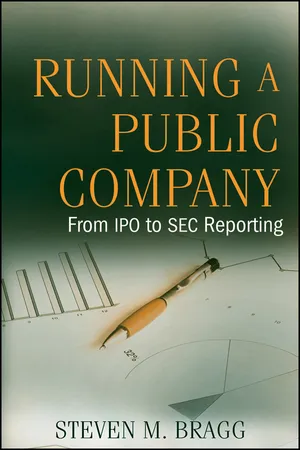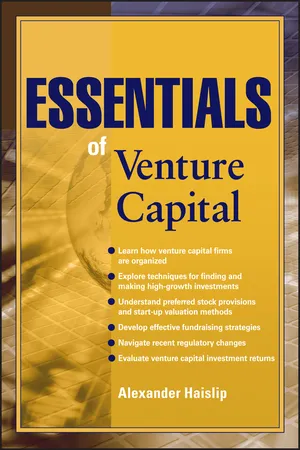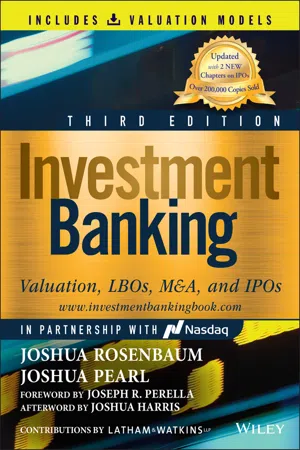Business
Going Public
Going public refers to the process of a privately held company offering its shares to the public for the first time through an initial public offering (IPO). This allows the company to raise capital from a wide range of investors and provides liquidity for existing shareholders. Going public also subjects the company to increased regulatory and reporting requirements.
Written by Perlego with AI-assistance
Related key terms
Related key terms
1 of 4
Related key terms
1 of 3
10 Key excerpts on "Going Public"
- eBook - ePub
Running a Public Company
From IPO to SEC Reporting
- Steven M. Bragg(Author)
- 2009(Publication Date)
- Wiley(Publisher)
PART IHow to Go PublicPassage contains an image
CHAPTER 1The Initial Public OfferingIntroduction
The initial public offering (IPO) is considered by many business owners to be the true sign of success—they have grown a business to the point where its revenue volume and profitability are large enough to warrant public ownership. However, the road to an IPO is both expensive and time consuming and requires significant changes to a company. This chapter describes the pluses and minuses of being public, as well as the steps required and costs to be incurred in order to achieve that goal.Reasons to Go Public
Though a management team may not say it, a major reason for Going Public is certainly to create a market for the shares they already own. Though these shares may not be available for sale for some time after the IPO, management will eventually be able to cash in its shares and options, potentially generating considerable profits from doing so. This reason is not publicized to the public, since the public would be less likely to invest if investors think the management team is simply cashing in and then leaving the business.A slight variation on the wealth creation theme is that, by having a broad public market for their shares, original shareholders are likely to see a rise in the value of their shares, even if they have no intention of selling the shares. The reason is that there is no longer a penalty for not having a ready market for the shares, which adds a premium to what the shares would have been worth if the company had remained privately held.The same logic can be used as a tool for employee retention. A private company can issue options to its employees, but they are worth little to the employees unless there is a market in which they can sell the shares. By Going Public, a company may experience increased employee retention, since they wish to wait until their options vest so they can cash in the resulting shares for a profit. - eBook - ePub
- Steven M. Bragg(Author)
- 2010(Publication Date)
- Wiley(Publisher)
Part Five Publicly Held CompanyPassage contains an image Chapter 15 Initial Public Offering
The initial public offering (IPO) is considered by many business owners to be the true sign of success—they have grown a business to the point where its revenue volume and profitability are large enough to warrant public ownership. However, the road to an IPO is both expensive and time consuming and requires significant changes to a company. This chapter describes the pluses and minuses of Going Public, as well as the steps required and costs to be incurred in order to achieve that goal.Reasons to Go PublicThough a management team may not say it, a major reason for Going Public is certainly to create a market for the shares they already own. Although these shares may not be available for sale for some time after the IPO (see the “Restrictions on Stock in a Publicly Traded Company” section), they will eventually be able to cash in their shares and options, potentially generating considerable profits from doing so. This reason is not publicized to the public, since they will be less likely to invest if they think the management team is simply cashing in and then leaving the business.A slight variation on the wealth creation theme is that, by having a broad public market for their shares, original shareholders are likely to see a rise in the value of their shares even if they have no intention of selling the shares. The reason is that there is no longer a penalty for not having a ready market for the shares, which adds a premium to what the shares would have been worth if the company had remained privately held.The same logic can be used as a tool for employee retention. A private company can issue options to its employees, but they are worth little to the employees unless there is a market in which they can sell the shares. By Going Public, a company may experience increased employee retention, since they wish to wait until their options vest so they can cash in the resulting shares for a profit. - eBook - ePub
Investor Relations
Principles and International Best Practices in Financial Communications
- Anne Guimard(Author)
- 2015(Publication Date)
- Palgrave Macmillan(Publisher)
Those who consider that living happily means living secretly should think twice before they decide to get listed, and wait until they come to believe that being thrust into the spotlight can in fact help them grow faster than competition. In addition, Going Public is an extremely strenuous exercise for these companies, one that can slow or even stop growth. In some cases, it may make sense, and be much wiser, to postpone the listing decision. 1.1 Why Go Public? Companies may turn to capital markets at a given point in time in their history to fund their expansion, build their corporate reputation, or enable existing shareholders to sell their shares at the best possible price. While this book is not intended as a complete guide to initial public offerings (IPO), it aims at focusing on the mission-critical role of Investor Relations throughout the process and well beyond (see Figure 1.1). Providing it offers and maintains a consistently clear understanding of its activities and strategies (microeconomic factors) along with updates on the environment in which it is operating (macroeconomic picture) on a regular basis, the company will be able to achieve the following: • Raise capital on the financial markets to help fund its development. Capital can be raised through debt (if the company issues bonds) or equity (if shares are issued). These two types of security can also be combined into hybrid instruments. The company’s Investor Relations program will relate to all of the securities issued since they are designed to reflect not only its overall image, but also to promote a specific category of securities. Equity can be a less expensive source of funding than bonds, but can be counterproductive if new issues dilute earnings per share. Different factors, such as financing costs and balance sheet structures, can prompt companies to issue other types of securities (bonds or hybrid instruments) - eBook - ePub
- George J. Papaioannou, Ahmet K. Karagozoglu(Authors)
- 2017(Publication Date)
- Academic Press(Publisher)
The decision to have an IPO, that is, to “go public,” is an important step in the life of a firm. The transformation from a privately owned to a publicly owned and traded company entails serious financial and organizational consequences for the firm’s governance and shareholders. The going-public decision should weight the costs and benefits of public ownership and trading against those of private ownership. When the net benefits of operating as a public firm overtake the net benefits of continuing as a private concern, a firm should consider to go public.The Motives for Going Public
The Wealth of Original Owners as a Constraint to Firm Growth
New firms are set up with equity capital contributed by the founders, family members, venture capital, and other financial backers called angels. After a period of incubation and development, the new firm reaches the point when it needs to scale up its operations to attain further growth. Often the capital required at that point may well exceed what its founders and backers can afford to contribute or what the firm’s banks are willing to lend. Therefore, gaining access to capital sources, especially for financially constrained firms, is a strong motive for an IPO (Poulsen and Stegemoller, 2008 - eBook - ePub
- Alan R. Simon(Author)
- 2010(Publication Date)
- For Dummies(Publisher)
Instead of a limited number of stockholders who represent the ownership population of the company, suddenly ownership is open up to the general public at large. Additionally, an IPO brings a whole new group of restrictions and constraints to a company’s operational and financial management. Suddenly, the company must report earnings (or losses) in great detail on a quarterly basis, along with regular reports of the company’s assets and liabilities, cash flows, and other financial measures. Regular filings with the Securities Exchange Commission (SEC) must also take place.But aside from the paperwork (which the company’s management should be doing anyway even when privately held), becoming a publicly traded company changes the game with regard to how the company is financially managed. Suddenly, a whole lot of know-it-alls at investment houses and stock brokerages make public statements about where they expect your company’s earnings to be in the upcoming quarter or next year, or maybe even make bold predictions that your company’s stock will underperform that of your closest competitors.Basically, a whole new set of external factors come into play following a company’s IPO. But the primary reason a company goes public is not to subject itself to those external factors, but rather to unlock value in its ownership and allow early investors and employees who hold options to partake in (hopefully) increasing stock prices.However, your company’s management may decide that Going Public isn’t really for them at all. Maybe the stock market conditions are poor enough that IPOs are far and few between and even those companies bold enough to attempt an IPO are finding their shares priced significantly below what they would have fetched only a year ago. Or, maybe, the company’s business strategy changes in such a way that the company would be better off maintaining a privately held structure.Or, along the way, your company’s management might receive an attractive enough offer from another company that they decide to sell the company in its entirety rather than pursue Going Public. See Chapter 16 for a complete discussion of what happens in general and to your stock options when your employer is acquired by another company. (Hint: Usually, the result is pretty good for your stock options!)Of course, if your employer cancels an IPO or never even files to go public, the reason could be because the company has turned out to be a flop. (You knew there was a dark cloud hanging over this discussion after all, didn’t you?) Even though many of the high-profile Internet companies that failed in 2000 were companies that had already gone public, thousands of failed companies never even made it to IPO day. - eBook - ePub
- David H. Fater(Author)
- 2009(Publication Date)
- Wiley(Publisher)
9. Fiduciary responsibilities. As the owner of a private company, the money you invested and risked was your own. Once you receive money from investors, the money you risk is theirs and decisions that you make have to be for the benefit of all stockholders. You become accountable to them! Too many times, I have seen chief executives of public companies view the company as still theirs and lead it and themselves to a very destructive ending.Decision to Go Public
The decision to go public is never an easy one. However, this decision does require a great deal of thought by management and the board of directors. The factors that will weigh into the overall decision to go or not go include timing and readiness of the company and the market.Is This the Right Time?
As in with most things in life, the timing of a company’s decision to go public is extremely critical. Go public too soon, and the company will be punished in the market. Go public too late and miss a market upswing, and the company will be punished in the market.If the decision to go public is driven by the need to obtain capital, consider whether that capital can be obtained from nonpublic sources. If so, maybe the decision to go public can be postponed, and the raised capital can be used to drive profitability and growth. Then the company’s value at the public transition will be increased, resulting in decreased dilution to existing shareholders.Is a well-developed strategic operating plan in place? If not, or if such a plan is not executed well, the performance of the stock in the public market will be adversely affected (i.e., go down), leaving investors with a bad taste in their mouths for the company and its prospects. Then it will be difficult (or impossible) to raise capital in the future as it is rare for impaired credibility to be repaired. - eBook - ePub
- Joseph W. Bartlett, Peter Economy(Authors)
- 2011(Publication Date)
- For Dummies(Publisher)
Chapter 15
Initial Public Offering (IPO)
In This Chapter
Exploring IPOsDeciding whether you want to go publicLearning how to do an IPOTaking your show on the roadA n initial public offering, or IPO — just the mere thought of those three little initials is enough to send even the most sober company owner, executive, shareholding employee, or investor into soaring flights of fancy and dreams of soon-to-come wealth that even last month’s Powerball lottery jackpot can’t hold a candle to. And why not? Although IPOs have been around for years — they’re the traditional way that fledgling companies first sell shares of stock to the public to raise capital — the recent explosion of technology firms and dot-coms has brought IPOs into the public consciousness like never before. Even with the demise of those same offerings (and companies), the IPO still is viewed as the “big cash out” for company founders, owners, and investors. Certainly, significantly fewer are occurring now than just a few years ago, but the market has again regained some measure of sanity.The initial offering of an issuer’s securities to the public often is a watershed event — an achievement of a goal the founders have sought since the inception of the company, especially for founders who look at the IPO as an exit strategy, an event when they finally are able to convert their stake in the business into cash. - eBook - ePub
- Alexander Haislip(Author)
- 2010(Publication Date)
- Wiley(Publisher)
The measure of a great investment is one that returns 10X an investor’s money over a normal five- to seven-year venture-investing time horizon. That means that a venture capitalist that puts $1 million into a start-up hopes to get back $10 million or more in a matter of years. It’s a rare occurrence, but that’s the goal.Going Public
The best way to get to10X returns and beyond is to take a start-up public. Going Public means selling a start-up’s common shares to institutional investors via a stock offering. Those large financial institutions can then sell the shares on a government-regulated exchange, such as the NYSE or the NASDAQ.The businesses that run stock exchanges impose certain requirements on companies that wish to trade stock on their markets, and each exchange has slightly different rules. More important to a start-up looking to sell shares to the public are the rules and regulations imposed by the federal government, which mandates company financial disclosures and certain corporate governance practices. Federal regulation plays a big role in how start-ups think about Going Public, but we’ll discuss more on that later.Interestingly enough, there are no provisions from either the government or the exchanges themselves that require listing companies to be profitable, or even to have any revenue at all. So there are no lower bounds on company size, assets, or operations. In fact, there’s a whole class of companies—special purpose acquisition corporations (SPACs)—that go public with no assets or operations at all!Could two graduate students in a garage go public? Yes. The only real question to consider is whether people would buy the stock.That’s something that investment bankers spend a lot of time trying to determine. A company, or its venture capitalists, will hire bankers to consult on a start-up’s chances of connecting with public market investors.But Going Public is something of a misnomer, as companies don’t actually sell their shares to the public in the process. Most of the time, they sell their shares to an investment bank that underwrites the IPO. The investment bank then sells those shares to its large institutional clients. The bank may promise to give a “best-efforts attempt” to sell the shares to its clients or may offer a “full commitment” to either sell the shares to its clients or buy them itself. - eBook - ePub
Investment Banking
Valuation, LBOs, M&A, and IPOs (Book + Valuation Models)
- Joshua Rosenbaum, Joshua Pearl(Authors)
- 2022(Publication Date)
- Wiley(Publisher)
PART Four Initial Public OfferingsPassage contains an image
CHAPTER 8 Initial Public OfferingsAn initial public offering (IPO) represents the first time a company (“issuer”) sells its stock to public investors. The shares are then traded on an exchange such as the Nasdaq Stock Market (Nasdaq), the New York Stock Exchange (NYSE), the London Stock Exchange (LSE), or the Stock Exchange of Hong Kong (SEHK). Collectively, these primary exchanges comprise what is commonly known as “the stock market”. Each publicly-traded company assumes a “ticker symbol”, typically a one-to-four-letter abbreviation that serves as a unique identifier. Once a company “goes public”, its shares will trade daily on the open market where buyers and sellers determine its prevailing equity value in real time.An IPO is a transformational event for a company, its owners, and employees. In many ways, the company and the way it operates will never be the same again. Detailed business and financial information will be made public and subject to analysis. Management will conduct quarterly earnings calls and field questions from sell-side research analysts. They will also speak regularly with existing and potential new investors. New accounting, legal, regulatory, and investor relations infrastructure and employees will need to be brought on board to handle public company requirements.While IPO candidates vary broadly in terms of sector, size, and financial profile, they need to feature performance and growth attributes that public investors would find compelling. Is the company and its addressable market large enough to warrant attention? Is it a market leader? How exciting is the growth opportunity? Is the cycle entry point attractive? How capable is the management team?Market conditions must also be conducive. The number of IPO offerings over a given time period is strongly correlated to the performance of the overall stock market. The better the market, the more plentiful the IPO pipeline. Similarly, in a down market, the IPO spigot slows to a trickle or may shut off entirely. Even a highly compelling candidate would most likely choose to wait rather than launch in an unfavorable market and risk an unsuccessful deal. - David R Williams(Author)
- 2013(Publication Date)
- Woodhead Publishing(Publisher)
7The initial public offering
Abstract:
This chapter examines the initial public offerings in the biopharmaceutical market sector. It focuses on U.S. firms that have gone public and offers insight into other markets. After giving a brief history of stock exchanges, it looks at the process of selling securities on a public exchange for the first time. It examines the role that underwriters (investment banks) play in bringing a security to market. The chapter looks at the costs of becoming a publicly traded firm and shows trends in this market and the effect of an IPO on the firm and its management. The chapter also examines the financial condition of firms that have gone public and historical trends related to stock price and net proceeds.Key words initial public offering research and development expenditures underwriting IPO process IPO costs7.1 An introduction to the initial public offering
The term initial public offering (or IPO) refers to the process by which a firm sells its stock for the first time on an open, public market. A public market is a place or system that allows for the exchange of a firm’s stock between individuals and entities. Examples of public markets or stock exchanges include the New York Stock Exchange (NYSE), NASDAQ, and the American Stock Exchange in the U.S., the London Stock Exchange in the United Kingdom, and Japan’s Tokyo Stock Exchange. Stock exchanges can be actual physical locations or virtual, on-line entities. Stock exchanges or markets allow individuals and entities the greatest opportunity to invest in other organizations.The reasons for firms to sell their stock on an open exchange include survival, growth, and exit1 –3
Index pages curate the most relevant extracts from our library of academic textbooks. They’ve been created using an in-house natural language model (NLM), each adding context and meaning to key research topics.
Explore more topic indexes
Explore more topic indexes
1 of 6
Explore more topic indexes
1 of 4









